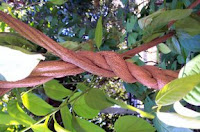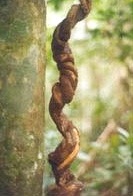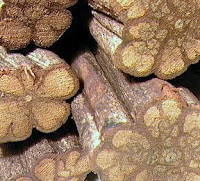Just about ten years ago, Amazonian shamans discovered, to their considerable surprise, that an American had patented ayahuasca.
 |
In 1981, Loren Miller, director of California-based International Plant Medicine Corporation, took a sample of ayahuasca back to the United States. Miller then patented it with the U.S. Patent and Trademark Office, claiming a new plant variety he called Da Vine, and in 1986 obtained exclusive rights to sell and breed the plant. It was not until ten years later that Amazonian native people became aware that one of their sacred plants was now under U.S. patent law. By 1998, Miller had received, and ignored, repeated requests from indigenous groups to give up the patent.
Finally, the Coordinating Body for Indigenous Organizations of the Amazon Basin (COICA), a group based in Ecuador and representing over 400 indigenous groups from eight countries, decided to take action. “Our goal is to have the ayahuasca patent annulled, and to teach all international biopirates a lesson,” said Rodolfo Asar, communications director of COICA.The organization informed its members that Miller was an “enemy of indigenous peoples,” and that “his entrance into all indigenous territory should he prohibited.”
A war of words ensued. The organization posted a notice on its website stating that it would not be responsible for any physical harm to Miller if he ventured into indigenous territory. Miller said he was given a sample of the plant by an indigenous community in Ecuador, but he refused to identify the community on the grounds that he wanted to protect residents from COICA, which he called a terrorist organization that had ruined the reputation of his business.
 |
Charging that the patent was improperly issued, indigenous groups challenged the claim at the U.S. Patent and Trademark Office, with the help of two Washington-based organizations, the Center for International Environmental Law and the Coalition for Amazonian Peoples and their Environment. The Plant Patent Act of 1970 was intended to protect growers breeding new plant varieties, and requires the person requesting the patent to be the original breeder. Since ayahuasca is widely used throughout the Amazon, and, botanical experts said, the patented plant was exactly the same as the natural variety, Miller could not claim to have been the “inventor” of the plant, and thus was not eligible for a patent. The shamans asked that the validity of the patent be reviewed on these grounds, and that request was approved.
Indigenous people of the Amazon have learned how to use photo opportunities. Querubin Queta Alvarado and Antonio Jacanamijoy Rosero, spiritual leaders of their Amazonian tribes, appeared at the headquarters of the U.S. Patent and Trademark Office wearing traditional garb — beads, feathers, and piranha teeth. Under their arms were official protest documents prepared by their attorneys.
In the fall of 1999, the PTO nullified the patent on the grounds that a specimen like Miller’s was on display at Chicago’s Field Museum at least a year before he applied for a patent. “Our shamans and elders were greatly troubled by this patent,” said Antonio Jacanamijoy Rosero. “Now they are celebrating.”
The celebration did not last.
 |
While the PTO had accepted the arguments that the claimed plant variety was not distinctive or novel, it had not acknowledged the argument that its religious value warranted an exception from patenting. In apparent violation of its own procedures, the PTO allowed Miller to submit new evidence and arguments, centering on the differences between his ayahuasca plant and museum reference plants. In January 2001, without having heard opposing views, the PTO reversed its rejection and, in April, issued a certificate allowing the patent to stand for the remaining two years of its term.
Ironically, after all his legal efforts, Miller was left with a patent that was virtually valueless. The patent he received protected only the specific genome of the patented plant and its asexually reproduced progeny — that is, exclusive rights over nothing more than his original plant and specimens grown from its cuttings. It did not give him rights over any other specimens of the ayahuasca vine, even specimens that might be identical in appearance.
Under the law, a patent applied for before 1995 expires seventeen years from the date it was originally issued. The ayahuasca patent expired on June 17, 2003. It cannot be renewed.

- Previous Post: Arrow Poisons
- Next Post: Mermaids
- More Articles Related to: Ayahuasca, Legal Issues



Shouldn’t the second last paragraph read – 2013? I am glad that his patent is worth very little. It was unethical and bloody minded to reapply after the native peoples complained.
I’m pretty sure the date is right. The patent was issued in 1986 and was good for seventeen years. 1986 + 17 = 2003. I agree with your comment. As the saying goes, when you find yourself in a hole, the first thing to do is stop digging. Miller just dug himself deeper into an indefensible position.
Stuff happens all the time. People go out and ask someone a question or two about this or that, maybe even elephants breeding habits, and then write a paper claiming to be an original researcher who has made a fascinating new discovery… Or, they see a plant growing in someone’s yard, ask them about it, learn that it has been taken care of by the family for six generations, then the “discoverer” names the plant after their two year old daughter…